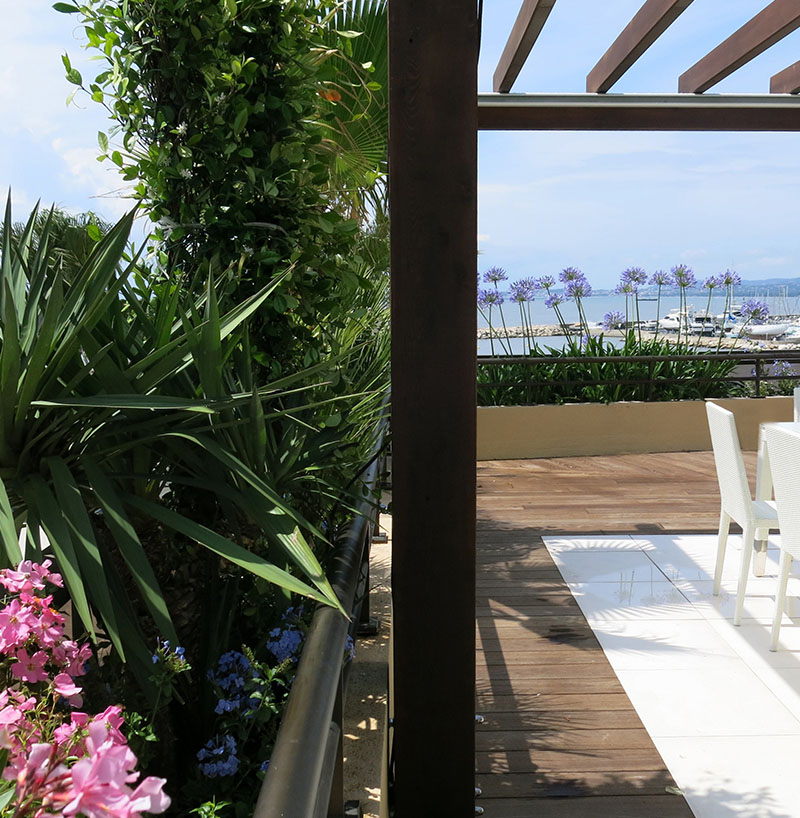Roof terraces are increasingly common as urban dwellers seek to make the most of outside space. Creativity is not limited with good design and landscaping as shown in our wide ranging portfolio.
Key elements of most roof terraces are seating areas, privacy, and planting to achieve a green space higher up in the sky line. These spaces can be hostile environments for certain species of plant and therefore we tend to use hardy plants that are used to coastal or drought tolerant conditions. The addition of irrigation and screening helps offset the environmental challenges. The main structural considerations for roof terraces include weight bearing of a structurally sound roof and planning permission. stylish furniture, waterfeatures, and lighting can transform a hard landscaped space into a tranquil oasis, or vibrant entertaining space.
As with all roof terraces on older buildings , there are limitations to the weight and loadings one can put on the roofing timbers. Therefore all materials and planting has to be designed to minimise the stress on the roof structure. The solution was Ipe decking, western red cedar benches, large enough to be used as day beds and sun loungers and caramel coloured steel planting containers. Good lighting will be crucial to this space.
As well as providing valuable outdoor space, roof gardens can reduce energy bills, cut noise pollution and provide a haven for wildlife.
Does your roof have the potential to be a terrace?
A terrace is potentially viable if you have an existing outside space that can be reinforced to be load-bearing, a window that can be changed for a door and new access can be created.
What if your roof isn’t flat?
A flat roof will be cheaper and easier to work with, but even if your roof is pitched there are options. An external wall can be built up to create a flat surface or you could get an ‘inverted dormer’ – that’s where they chop a chunk out of the roof.
How big will it be?
The amount of space often depends on privacy issues [such as a terrace overlooking a neighbour’s property]. If so, the boundary line is often brought back. Screening is also often suggested in the form of opaque-glass panels. And the hatch or stairs on to the roof will eat up some of the space.
How much will it cost?
A basic roof terrace may cost upwards of £7,500, but it’s possible to spend up to £45,000 easily. In the long term it will pay for itself, if not make you a profit; properties with a roof terrace are are worth between 10 and 25 per cent more after the work is done. Remember to save some of the budget for furniture and accessories.
Before you start…
Find out from your architect whether you will need planning permission, then contact the local planning authority to make an application. Even if what you’re planning doesn’t require permission, always tell your neighbours what you are intending to do – it’s a goodwill gesture that will make them less likely to complain. The other option is to contact an architect who can take care of the planning permission and hiring builders.
Now accessorise
Great fun can be had with the addition of illuminated lightweight outsize planters and shade sails for ultrasunny terraces. There is a wide choice of fire pits which will warm you as the daytime temperatures fall and grill your supper at the same time. The main things to think about are:
Planting: Go for plastic or fibreglass pots and mix normal compost with a product such as perlite or hydroleca to minimise the weight on the roof while still retaining water well. These are available from all good garden centres. Bear in mind the aspect of the terrace – sheltered terraces can have some success with Mediterranean plants such as olives and even oranges; for windy, exposed terraces, grasses and bamboo cope well.
Furniture: Go for lightweight pieces that are easy to maintain and if they’re flatpack, assemble them on the terrace.
Lighting: This is the key to creating atmosphere after dark and should be thought about during the design process. A couple of waterproof power sockets might be useful for additional appliances. Circuit breakers and lighting specifically designed for the outdoors will prevent any shocks.

